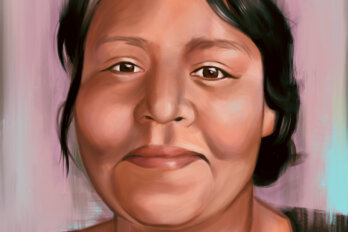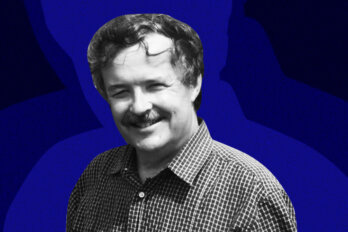Listen to an audio version of this story
For more audio from The Walrus, subscribe to AMI-audio podcasts on iTunes.
Chad Guenter, a firefighter and rescue instructor in Canmore, Alberta, stands six-foot-three, weighs 250 pounds, and is covered in tattoos. He has seen a lot of troubling things while working: a seven-day-old baby who died of cardiac arrest, the bodies of three railroad engineers he helped recover from the crumpled wreck of a freight train. But, sometimes, it’s the routine calls—like the elderly man who showed signs of stroke and reminded him of his father—that send him reeling. Over years of occupational stress, Guenter has talked to therapists about his flashbacks and heavy feelings. But, for immediate relief, he goes to the river. “When I’m on the water, there’s nothing else that I have to worry about—nothing else,” says Guenter, whose stand-up paddleboard has helped him cope with the trauma he experiences as a first responder. “Water demands all of my attention. It’s really healing.”
Guenter, who surfs in the rapids near his home, in the Rockies, and escapes on long-distance paddleboard journeys, launched a community group, Keep Calm and Paddle On, in 2012. Inspired by a 300-kilometre solo paddle along Lake Diefenbaker and the South Saskatchewan River to his hometown of Saskatoon, he has led annual multiday trips with dozens of participants. People push outside their comfort zones while reflecting on and talking about their inner struggles in a supportive atmosphere. “Our thoughts get pulled in so many different directions, but if you focus on what needs to be done, it can help you navigate your life,” says Guenter. “Getting into the rhythm of a paddle stroke can be meditative, but it’s much more than that. Maybe it’s because we don’t spend much time on the water anymore while past generations needed water. Maybe it’s because water is so much bigger than us. I get choked up thinking about it, but that’s okay. Calm seas never made a good sailor.”
The restorative qualities of being in nature, or “green space,” are well documented, but researchers have only recently begun to focus on what changes when water is part of the picture, when we spend time in or near aquatic environments. Taking in the sea air, strolling along a peninsula, or simply sitting beside a pond have long been considered good for our well-being, but evidence is emerging that “blue space” may have a more profound impact on our bodies and brains than other outdoor environments do.
Although he was born on an island off the south coast of England and loves surfing, Mat White followed a roundabout route to becoming perhaps the world’s leading authority on blue space, expertise that evolved out of research into links between nature and well-being in the UK around a dozen years ago. As a young psychologist studying the environment’s effects on human health, White investigated connections between mental health indicators and how people spent their days. Now based at the University of Vienna, he is researching what happens when we do anything (swim, surf, walk, sit) in, on, or near a body of water: an ocean, a lake, a river, even a fountain. From 2016 until it wrapped up last year, he helped lead BlueHealth, a pan-European research network that examined the nexus between urban blue spaces, climate, and health. BlueHealth projects used measures such as heart rate, blood pressure, surveys administered by trained interviewers, and self-reported wellness, with several studies involving virtual reality or subjects looking at photographs of water. For one paper, White crunched some big numbers—a UK census of approximately 48 million adults—and found that, the closer people live to the coast, the healthier and happier they are, a conclusion he and his collaborators attributed to increased opportunities for stress reduction and physical activity. “The crucial point about that research was that it was the poorest communities and individuals who got the benefits,” he says, referring to both physiological and psychological well-being. “It didn’t really matter where rich people lived; they were healthy anyway.”
The quality of blue spaces affects their therapeutic properties, as does how we interact with them, variables influenced by geography as well as by cognitive and cultural differences. For example, people often prefer places they visited as children, according to White. But, on the whole, when we’re near water, we tend to lose track of time and are more active, he says, and every extra minute of movement is good for our physical health. Moreover, “people benefit more mentally when they’re visiting blue spaces than when they’re visiting green spaces,” adds White, although the ideal, he clarifies, is where the two spaces meet.
Natural areas often have some sort of aquatic element, from barely trickling streams in urban ravines to pounding waves below clifftop hiking trails. But not always. The lines between green and blue (and, in a Canadian winter, white) spaces are blurry, yet wellness surveys point to a hierarchy. In one study in the Netherlands, respondents used a smartphone app to record their level of happiness: those visiting natural coastal environments were roughly twice as happy as those in forests and three times happier than people in agricultural terrain. Manicured parks and grassy areas with low-lying vegetation typically score well, and mountains extremely well, but nothing beats water. A mountain lake, according to White, may be the ultimate happy place.
The reasons for these findings are complicated and involve evolution, biology, neuroscience, and concepts such as “flow”—a state in which people are so immersed in an activity that nothing else seems to matter. Essentially, blue space has four triggers that activate our parasympathetic nervous system, which controls body function while at rest, explains Jenny Roe, the director of the University of Virginia’s Center for Design and Health. First, water instills a sense of being away. It can be either tranquil or dynamic, conditions that can make you introspective or attuned to your surroundings, both of which serve as escapes from your habitual behaviour. Second, it conjures a feeling of “extent,” of being in a boundless environment (especially large bodies of water) where possibilities feel limitless. Although one can also experience these glimpses of a wider world while, say, hiking, they’re amplified in blue space by acts like looking to the horizon or into the depths of a lake. Third, the sounds and sights of water—as it runs over rocks or dances in the sunlight—spark both “hard fascination,” a concentration of our focus through stimulation, as well as “soft fascination,” an unconscious capturing of our attention that requires little effort and frees the mind. And, fourth, water confers a sense of compatibility with our location, of comfort and belonging.
“Humans are hardwired to connect with water,” says Roe, citing a phenomenon called biophilia, the idea that our intimate relationship with the natural world is rooted in genetics. This meshes with the “old friends” hypothesis: that time in nature puts us in contact with vital microbes we had been exposed to throughout human existence—until we began living in more sterile and mostly urban environments. When people are near turbulent waters, such as waves or a waterfall, they may be getting showered by microbiota that boost their immune systems. Although “the science isn’t there yet” to make serious claims about this theory, White says, “people have been going to these places for thousands of years, and I don’t think we should just dismiss that wisdom.”
In 2019, Roe helped conduct a study in West Palm Beach, Florida, where a section of the downtown waterfront was modified with a few low-cost additions: tables and chairs, plants that provided shade and buffered traffic sound, and wooden “fascination frames” that encouraged people to stop and gaze out at the harbour. Study participants also walked along part of the waterfront that had not been improved. Using a mood scale to capture subjective well-being plus smart watches to track heart rate variability, the research team found that stress reduction was markedly higher in the modified scenario. It was a small study, Roe cautions, but it showed that a simple change can have a discernible impact. Urban planners and public health advocates, she writes, “can use the knowledge gleaned here to take full advantage of underused, underperforming, or otherwise neglected water spaces in a city.” Roe is now doing an experiment that involves subjects looking at images of blue, green, and “grey” urban spaces while wearing headsets that capture cortical brain activity, signals that can be translated into alpha waves (which indicate relaxation) and beta waves (higher cognitive attention demands). But understanding what happens inside our brains when we see water is only the first step toward using that science to shape policy.
In the UK, one of the projects under the BlueHealth umbrella took place in Plymouth’s Teats Hill, a low-income neighbourhood on a postindustrial waterfront where locals avoided the small beach because it was unkempt, neglected, and strewn with trash. City council secured a grant, commissioned landscape architects, and consulted the community to plan a redevelopment. It featured an open-air theatre, seating, an improved slipway to make it easy to launch personal watercraft, and a lawn with a view of the harbour. The cost was around $150,000, and surveys assessed the well-being of area residents before, during, and after construction. Psychological health increased, as did perceptions of community cohesion. Families played in the park, seniors sat on benches, and people took forays onto the sea. “The goodness isn’t just the water,” says White, mentioning another study, which found that people hang out at German rivers and lakes the same way they do at ocean beaches, spending quality time with one another because of the sense of belonging they feel. “It’s a behavioural interaction that water encourages. This is one of the reasons we think blue spaces tackle health inequalities. They’re social spaces that draw us into cross-generational play.”
Although the payoffs in Plymouth appear to justify the redevelopment’s relatively modest price tag, it’s difficult to valuate this type of project. Instead, social return-on-investment analyses are increasingly used to measure the effectiveness of aquatic cleanup and accessibility efforts, and governments need these figures to make informed decisions. But, even though White sees the potential for blue-space research to improve urban planning, study results don’t necessarily translate into prescriptions for change. “Every time we speak to policy makers,” he says, “they ask us, ‘How much is this worth? I don’t deal with budgets of well-being. I deal with budgets of money. Where do I shift money to?’”
On the western shore of Lake Michigan, at the confluence of three rivers, Milwaukee, Wisconsin, has taken an omnibus approach to refocusing the city’s gaze on water. In 2013, as part of its overarching sustainability plan, the municipal government began making it easier for local businesses, nonprofits, academics, and civic officials to collaborate on education and awareness efforts as well as on projects to improve access to blue spaces. Initiatives ranged from an accessible kayak launch in a dense area near downtown to a rain-capture system at a school, where water from the roof flows through a classroom in a clear pipe—an absorbing reminder to children about the role of this resource in their lives. “A lot of people in Milwaukee didn’t think much about waterways or sewage systems before,” says the city’s sustainability program coordinator, Elizabeth Hittman. “We’re doing a little bit of everything, from infrastructure to programming, to try to change that.”
People who spend time in nature are more apt to display pro-environmental behaviour, such as buying local and cycling instead of driving. They feel a connection and, accordingly, a sense of stewardship. To Mark Mattson, president of Toronto-based watershed protection agency Lake Ontario Waterkeeper and its parent advocacy organization, Swim Drink Fish, this connection is the bridge between more widespread access to blue space and improved human and planetary health. Canada is a country of rivers and lakes and coastlines, but safe and equal access to blue space here is often limited, Mattson says. In large urban centres, waterways have been the domain of industry for decades, and residents haven’t felt drawn to shorelines or lakefronts for leisure or exercise. During the COVID-19 pandemic, Swim Drink Fish set its sights on Toronto’s forty-six kilometres of largely inaccessible lakefront, pushing for developments such as a new east-end revitalization plan that will feature boat launches, lakeside pools, an amphitheatre, and open-water swimming—a redesigned urban blue space. “We have a chance to come out of the pandemic feeling more connected to nature in our own backyards,” says Mattson, “with a greater appreciation for the way water heals us.”




